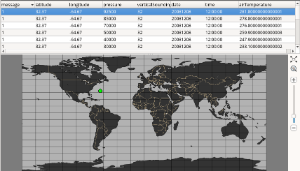...
In the examples below we will work with two coordinates to extract radiosonde data on certain levels: pressure will be the outer coordinate and verticalSoundingSignificance, which defines the type of the pressure levels, the inner coordinate. It reflects how a pressure block is built up in our radiosonde BUFR file:
 Image Removed
Image Removed Image Added
Image Added
| Task | Filter | Results | Comments |
|---|
For station 78016: extract all the temperature values on standard pressure levels |
| Code Block |
|---|
identifier_value: 78016
extract_data: on
parameter_1: airTemperature
coordinate_condition_count: 2
coordinate_1: pressure
coordinate_2: verticalSoundingSignificance
coordinate_operator_2: =
coordinate_value_2: 32
extract_mode: all |
|  Image Modified Image Modified
| verticalSoundingSignificance is a FLAG TABLE (bit-vector) and its value is 32 for standard pressure levels:  Image Modified Image Modified
|
| For station 78016: extract all the temperature values on temperature significant levels where the pressure is less than 500 hPa |
| Code Block |
|---|
identifier_value: 78016
extract_data: on
parameter_count: 1
parameter_1: airTemperature
coordinate_condition_count: 2
coordinate_1: pressure
coordinate_operator_1: <
coordinate_value_1: 50000
coordinate_2: verticalSoundingSignificance
coordinate_operator_2: =
coordinate_value_2: 4/68
extract_mode: all |
|  Image Modified Image Modified
|
|
This set of examples is based on file tropical_cyclone.bufr (click here for details).
| Example | Filter | Results |
|---|
For the first message (storm IN-FA) extract the storm centre pressure values along the track for ensemble number =2 |
| Code Block |
|---|
message_index: 1
custom_condition_count: 1
custom_value_1: ensembleMemberNumber
custom_operator_1: =
custom_value_1: 2
extract_data: on
parameter_count: 1
parameter_1: pressureReducedToMeanSeaLevel
extract_mode: all |
|  Image Modified Image Modified
|





